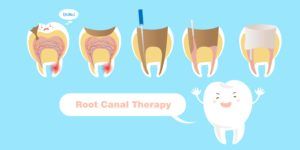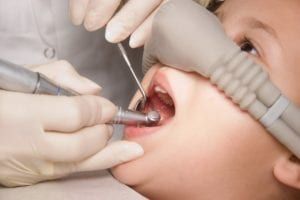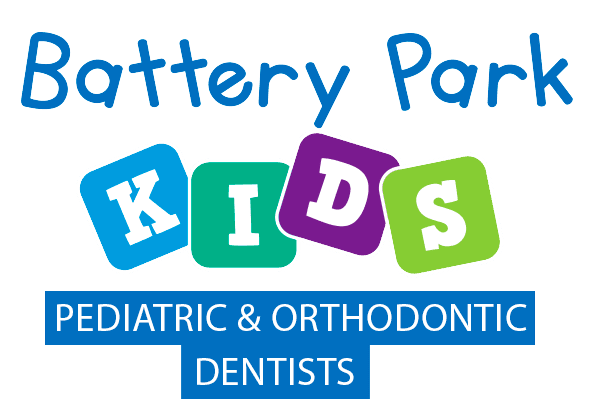Pulp therapy for baby teeth, also known as root canal, pulpotomy, pulpectomy, or nerve treatment, works to treat inflamed pulp in order to restore and save the affected tooth. Pulp is the innermost layer of the tooth and contains nerve and blood vessel tissue. Tooth decay or damage to the tooth can cause this layer to become exposed and/or inflamed. Without pulp therapy, the tooth can be prematurely lost or may require extraction.
There are two kinds of pulp therapy for baby teeth: vital pulp therapy and non-vital pulp therapy.
- Vital Pulp Therapy: used when the tooth’s pulp can be saved, and consists of removing the diseased pulp tissue only and preserving the healthy pulp tissue. Once the diseased tissue is removed, an agent is placed to prevent bacteria from growing and to relieve pain. Then the entire tooth is restored, usually with a stainless steel crown.
- Non-Vital Pulp Therapy: used the entire pulp, all the way down to the root canals, is diseased. In non-vital pulp therapy, all the pulp is removed from the entirety of the tooth. Then the root canals are cleaned and filled with a special material that can be safely absorbed by the body to allow for the primary tooth to eventually fall out and make room for the permanent tooth. Finally, the entire tooth will be restored with a stainless steel crown to prevent fracturing.

Did You Know?
According to the World Health Organization (WHO), approximately 60-90% of school-aged children around the world suffer from dental cavities severe enough to require dental treatment.
Frequently Asked Questions:
Does my child need pulp therapy for their baby teeth?
Your child may need pulp therapy for their baby teeth if they are suffering from tooth pain for no apparent reason, they have a tooth or teeth that is sensitive to temperature changes, you notice swelling or redness around the teeth, or if they have a broken tooth. However, not all children who need baby root canals are symptomatic. Some children will show no symptoms, which is why it is so important to maintain regular dental checkups every six months. To find out for sure if your child needs pulp therapy for their baby teeth, schedule a consultation with Battery Park Pediatrics today!
Why pulp therapy?
Pulp therapy for baby teeth is important to prevent the loss of your child’s tooth. Although your child will eventually lose their baby teeth, prematurely lost teeth can cause issues. Baby teeth are required for proper speaking and eating, as well as to preserve adequate space for permanent teeth. When baby teeth are lost too soon, it can cause crowding in neighboring teeth that results in crooked or tilted permanent teeth. Pulp therapy preserves your child’s primary teeth and increases the chances that their permanent teeth will erupt without complication.
Will my child be sedated during their pulp therapy treatment?
Most pulp therapy treatments can be performed using only a local anesthetic, or temporary pain blocker. However, in cases where the child may be excessively anxious or unable to sit still, nitrous oxide may be used as a sedative.

Nitrous oxide, also known as laughing gas, is an inhaled sedative that produces feelings of calmness and even euphoria. It is used to alleviate anxiety and keep children relaxed during dental procedures. The American Academy of Pediatric Dentistry states that nitrous oxide is safe for use in children and produces no long-term side effects. In fact, the effects of nitrous oxide wear off as soon as the gas is no longer being inhaled. This means that your child should be back to their normal self shortly after their appointment.
In some rare cases, a heavier sedation may be required. If this is the case, you must receive clearance from your child’s pediatrician. Dr. Roxanna Khajavi and Dr. Ryan Trulby will discuss the guidelines with you for this type of sedation.
How should I prepare my child for their pulp therapy appointment?
To help prepare your child for their appointment, you should explain the procedure to them in kid-friendly and honest terms. You may want to avoid using scary language such as drills, pain, or needles, and instead explain that they may feel a little poke at the beginning, hear a whirring sound during the procedure, but that they won’t feel anything. You will want to answer any questions they have as honestly as possible so they don’t feel like you are hiding anything from them.
The day of their appointment, you will want to maintain your composure and be calm so that they can remain calm as well. You may also suggest bringing a comfort item with them, such as a favorite toy or blanket. You can also explain to them that you will be with them the entire time.
If your child is receiving sedation, there are additional preparations you will need to adhere to. With nitrous oxide sedation, you will want to only feed your child a light meal the morning of their procedure. Toast is usually recommended. If your child is having heavier sedation, you will first need to obtain clearance from their pediatrician and then adhere to strict NPO guidelines to ensure your child’s safety. One key feature of NPO guidelines is fasting for 6-8 hours before their procedure.
What should I expect when my child is undergoing pulp therapy for baby teeth at Battery Park Pediatrics?
When your child undergoes pulp therapy, you will be able to accompany them and provide them comfort during the procedure. To keep your child calm and still during their procedure, Battery Park Pediatrics may use nitrous oxide as a sedative. We also use a local anesthetic to keep them comfortable and pain-free during the procedure.

Once your child is situated and prepared for the procedure, Dr. Roxanna Khajavi and Dr. Ryan Trulby will begin by gently drilling a hole in your child’s tooth. This will allow them to pass through the enamel and dentin layer to reach the pulp within the tooth. Once within the tooth, some or all of the pulp may be removed using a special file. In cases where only some of the pulp tissue is decayed, only the decayed tissue will be removed and the healthy tissue will be left. For most cases, this is the general practice. However, in cases where the decay has reached the root canals, all the pulp within the pulp chamber and root canals will need to be removed.
After the decayed pulp is removed, the remaining pulp chamber and canals, if needed, will be thoroughly cleaned to remove any remaining bacteria. The remaining the pulp chamber, and possible canals, will then be filled with a special material called gutta percha that will support the tooth. Gutta percha is a natural, biocompatible material that has a rubber-like consistency. A baby crown will then be placed on the top of the affected tooth to protect it until it later falls out.
What should I expect after my child undergoes pulp therapy?
After your child’s pulp therapy procedure is complete, they should not experience any more pain as a result of infected pulp. They may however have some tooth sensitivity to hot or cold temperatures for the first two weeks following their procedure.
If only local anesthetic was used, your child will be immediately alert following their procedure. If nitrous oxide was used as a sedative, your child will be fully alert within a few minutes after they stop inhaling the gas. If heavier sedation was used, your child may be drowsy for the entire day following the procedure and you will need to watch them closely.
In the days following their pulp therapy procedure, it is important to have your child continue brushing twice a day and flossing once a day. This will help keep their mouth clean and prevent the need for future pulp therapy procedures.
What is the difference between a baby root canal and an adult root canal?
Pulp therapy, or root canals, performed on baby teeth are different than root canals performed on permanent teeth. Baby root canals are unique in that they do not use a permanent filling inside the nerve canal. This is because primary, or baby, teeth eventually shrink away from the gums and fall out to make room for permanent teeth.
Another main difference between baby root canals and adult root canals is that decay spreads faster in primary teeth than it does in permanent teeth. Also, the decay found in primary teeth can spread to the underlying permanent teeth if not treated in a timely manner. This is one of the main reasons it is so important to seek pulp therapy treatment for a baby tooth infected with decay.
How can I prevent the need for pulp therapy on my child’s teeth?
To prevent the need for pulp therapy, or baby root canals, you will want to make sure your child is practicing good oral habits. You will need to help your child brush their teeth twice a day for two minutes at a time using and ADA-approved, fluoridated toothpaste. You will also need to floss between their teeth at least once a day to remove plaque and other debris.

In addition to maintaining a regular dental routine, you will also want to reduce their sugar intake, because sugars feed the bacteria that cause tooth decay. It is recommended to avoid or significantly limit the amount of sodas or fruit drinks consumed and instead encourage your child to drink water or sugar-free juices. In cases where sugar is consumed, it is recommended to have your child brush after to avoid the sugar from sitting on the surface of the teeth.
Finally, you will want to be diligent to prevent baby bottle tooth decay. Baby bottle tooth decay occurs when a baby is put to sleep with a bottle containing a sugar-filled beverage. As the baby falls asleep, the liquid pools around the teeth, contributing to tooth decay. To prevent baby bottle tooth decay, avoid putting your baby to sleep with a bottle or fill the bottle with water only.

